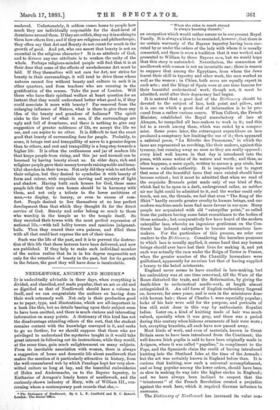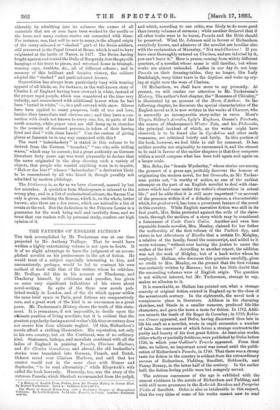NEEDLEWORK, ANCIENT AND MODERN.*
IT is undoubtedly advisable in these days, when everything is divided, and classified, and made popular, that an art so old and so dignified as that of Needlework should have a volume to itself, and we can congratulate the authors on having done their work extremely well. Not only is their production good as to paper, type, and illustrations, which are all-important in a book like this, but no details bearing upon their subject seem to have been omitted, and there is much curious and interesting information on many points. A dictionary of this kind has not the disadvantage attending others of the sort, that the student remains content with the knowledge conveyed in it, and seeks to go no further, for we should suppose that those who are privileged to understand the mysteries taught in it would take great interest in following out its instructions, while they would, at the same time, gain much enlightenment on many subjects. From its inevitable association with women, there is always a suggestion of home and domestic life about needlework that makes the mention of it particularly attractive in history, from the well-remembered web by which Penelope kept her very slow- witted suitors so long at bay, and the beautiful embroideries of Helen and Andromache, on to the Bayeux tapestry, to Katharine of Arragon's lonely hours of needlework, and the curiously-shown industry of Mary, wife of William III., con- cerning whom a contemporary poet records that she,—
The Dictionary of Needlework. By S. L. F. Canifeild and B. C. Seward. London: The Bazaar Office.
"When she rides in coach abroad Is always knotting threads,"
an occupation which would rather amaze us in our present Royal Family. It is always a blow to be reminded, however, that therein no certain warranty of the Bayeux tapestry having been exe- cuted by or under the orders of the lady with whom it is usually connected, and there is even a tradition that it was worked and. presented to William by three Bayeux men, but we would hope that this story is unfounded. Nevertheless, the connection of needlework with women is not an invariable one; there is reason to suppose that among the Egyptians, from whom the Jews learnt their skill in tapestry and other work, the men worked as well as the women ; in China, both sexes are equally expert in such arts ; and the Kings of Spain were at one time famous for their beautiful ecclesiastical work, though not, it must be admitted, until after their degeneracy had begun.
It is natural that a good deal of the Dictionary should be devoted to the subject of lace, both point and pillow, and it is one on which a great deal of information is to be pro- cured from a rather curious source. When Colbert, the French Minister, established the Royal manufactory of lace at Alencon, he compelled all lace-makers to work in it; and this led to a revolt among them, which was ended by a compro- mise. Some years later, the extravagant expenditure on lace produced a sumptuary law limiting the use of it; then appeared a satirical poem, "La Rdvolte des Passemens," in which the laces are represented as revolting, like their makers, against this tyranny, but running away as soon as they are really opposed : every kind well known in that day is introduced into the poem, with some notice of its nature and worth ; and thus, as often happens, a mere squib, written to amuse a gay circle, has become a valuable authority. It is impossible not to regret that some of the beautiful laces that once existed should have become extinct ; but it must be admitted that when we read of the exquisite Brussels point made only of one kind of flax, which had to be spun in a dark, underground cellar, as neither air nor light could be admitted to it, and the worker could only touch, not see, the threads, we feel that even "The Song of the Shirt" hardly records greater cruelty to human beings, and our modern machine-made laces find more favour in our eyes. Many people are acquainted with old "caterpillar point," so called from the pattern having some faint resemblance to the bodies of those animals ; but comparatively few have heard of the modern caterpillar lace, whereby an ingenious gentleman on the Con- tinent has induced caterpillars to become unconscious lace- makers. For the particulars of this process, we refer our readers to the Dictionary. Considering the harmless purposes to which lace is usually applied, it seems hard that any human beings should ever have lost their lives for making it and yet such was actually the case under the Reign of Terror in France, when the greater number of the Chantilly lacemakers were guillotined, apparently for no crime but that of having supplied a luxury to the hated aristocrats.
England never seems to have excelled in lace-making, but her embroidery was at one time renowned, till the Wars of the Roses disturbed the trade, and the Reformation, by giving the death-blow to ecclesiastical needle-work, at length almost extinguished it. An odd form of English embroidery lingered on, however, for some years, and is seen in the miniatures done with human hair ; those of Charles I. were especially popular ; locks of his hair were sold for the purpose, and portraits of him still exist done in this way by enthusiastic Royalist ladies. Later on, a kind of knitting made of hair was much valued, specially when it was grey, and there was a period during this century when hideous ornaments of hair were worn ; but, excepting bracelets, all such have now passed away.
Most kinds of work, and even of materials, known in Great Britain seem to have been introduced from the Continent; the well-known Irish poplin is said to have been originally made in Avignon, where it was called " papeline," in compliment to the Pope, and the Spaniards claim the credit of having introduced knitting into the Shetland Isles at the time of the Armada ; but the art was certainly known in England before then. It is curious that knitting, now such a universal accomplishment, and so long popular among the lower orders, should have been so slow in making its way into the higher circles in England ; and we have always been inclined to suspect that the " tricoteuses " of the French Revolution created a prejudice against the work here, which it required German influence to overcome.
The Dictionary of Yeedlework has increased its value con.- siderably by admitting into its columns the names of all materials that are or ever have been worked by the needle or the loom, and many curious stories are connected with these. - For instance, one, that will be new to many, is the alleged origin of the many-coloured or " slashed " garb of the Swiss soldiers, still preserved in the Papal Guard at Rome. which is said to have originated at the battle of Nancy, in 1477. The Swiss, having fought against and routed the Duke of Burgundy, tore the gay silk hangings of his tents to pieces, and returned home in triumph, wearing caps, doublets, &c., all of different colours ; and in memory of this brilliant and decisive victory, the soldiers adopted the " slashed " and parti-coloured dresses.
Superstition has always been particularly busy with wearing apparel of all kinds, as, for instance, in the well-known story of Charles I. of England having been crowned in white, instead of the proper regal purple, which was considered at the time very unlucky, and remembered with additional horror when he had been "buried in white," i.e., in a pall covered with snow. Gloves have been applied to many purposes, both of war and love, besides their immediate and obvious one ; and they have a con- nection with death not known to every one, for, in parts of the north country, white-paper ones are still hung up in churches to the memory of deceased persons, in token of their having lived and died "with clean hands." Can the custom of giving gloves at funerals be in any way connected with this ?
The word " haberdashery " is stated in this volume to be derived from the German " tauscher," "one who sells trifling wares," which may be correct ; but a great authority on German literature forty years ago was wont pleasantly to declare that the name originated in the shop showing such a variety of objects, that people who wanted anything went in to inquire, "Nab er des hier ?" whence "haberdasher !" a derivation likely to be remembered by all who heard it, though possibly not admitted by modern philology.
The Dictionary is, as far as we have observed, marred by but few mistakes. A quotation from Shakespeare is referred to the wrong play, and in a list of ecclesiastical colours, the Sarum Use only is given, omitting the Roman, which is, on the whole, better known; also there are a few errors, which are noticed in a list of errata at the end. But the dedication to the Princess Louise is a guarantee for the work being well and carefully done, and we trust that our readers will, by personal study, confirm our high opinion of it.



































 Previous page
Previous page